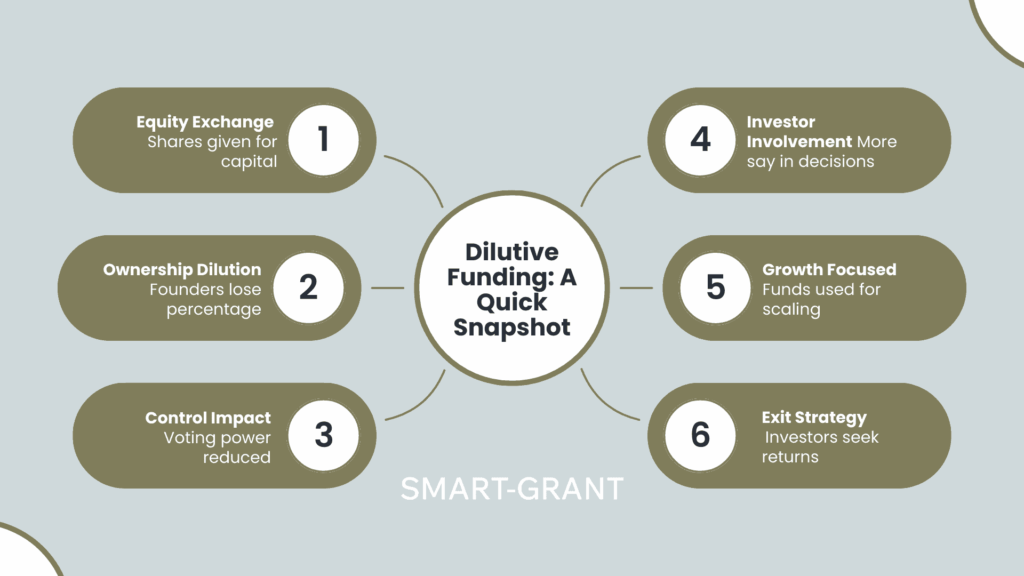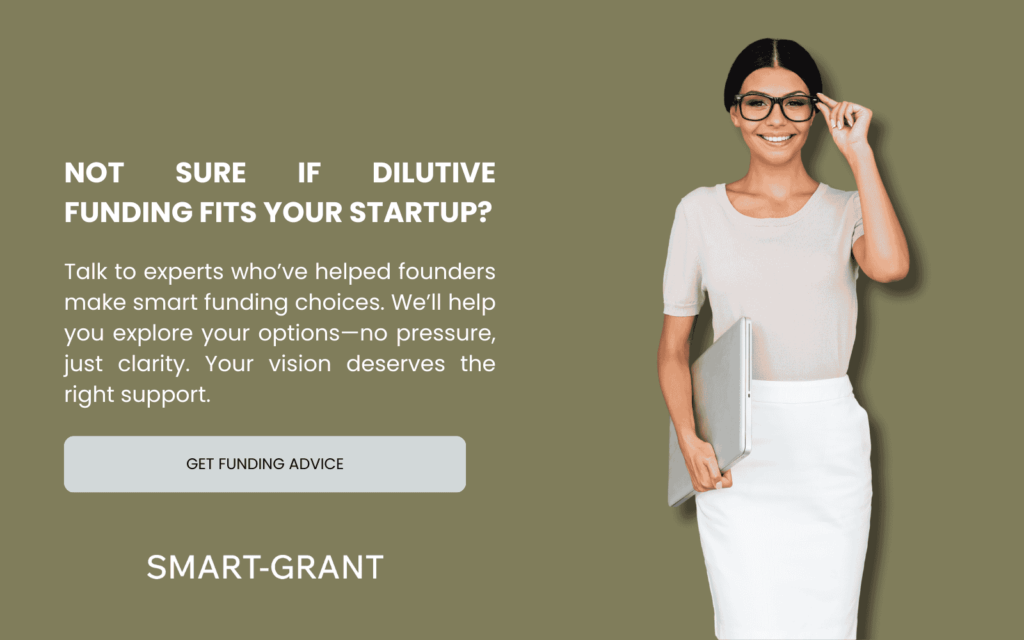A lot of people are asking what dilutive funding is. Dilutive funding forms a crucial element in the modern business financing landscape, particularly for small and medium businesses (SMBs) looking to scale operations. This article offers a thorough examination of dilutive funding mechanisms, practical applications, and alternative financing routes that protect your equity position.
We’ll examine different dilutive funding types, qualification criteria, application procedures, and smart strategies to secure capital while minimizing dilution. The focus remains on helping you make informed decisions about whether this financing option aligns with your business goals.
By the conclusion, you’ll possess practical knowledge to navigate dilutive funding options and determine if this capital route suits your business growth ambitions, or if alternatives like match funding present better opportunities for your specific situation.

What Is Dilutive Funding?
Dilutive funding refers to any financing method that reduces the ownership percentage of existing shareholders by issuing additional shares or equity-based instruments to new investors. This type of funding occurs when a business exchanges partial ownership for capital.
For businesses (especially SMBs), dilutive funding typically means that for every dollar you receive from investors, you surrender a portion of your business ownership. The relationship operates as an exchange between your company and capital providers, where you sacrifice future profits and control in return for immediate financial resources.
At its core, dilutive funding operates on risk transfer principles. When your business accepts external investment, you transfer some risk to investors who now share in both potential success and failure. This ownership sacrifice creates divergent interests that must be carefully managed.
Dilutive funding differs significantly from non-dilutive financing options:
| Funding Type | Ownership Impact | Repayment Requirements | Risk Profile |
| Dilutive Funding | Ownership dilution | No direct repayment but profit sharing | Investor bears partial risk |
| Match Funding | No equity dilution | Often non-repayable | Shared risk model |
| Bank Loans | No equity dilution | Full repayment plus interest | Business bears full risk |

Types of Dilutive Funding Available for Businesses
Dilutive funding options span various structures with different dilution impacts and investment terms:
1. Venture Capital
Venture capital firms provide substantial funding in exchange for significant equity stakes, typically targeting high-growth businesses with scalable models. These investments usually involve ownership percentages between 10-30% per funding round and focus on companies with clear paths to substantial market growth or disruption potential.
2. Angel Investment
Individual investors offer capital to early-stage businesses in exchange for equity ownership. Angel investments typically involve smaller equity portions than venture capital (often 5-15%) but may come with more flexible terms. These investments frequently target nascent businesses with promising concepts but limited operational history.
3. Equity Crowdfunding
Modern investment platforms enable businesses to raise capital from numerous small investors, each receiving tiny equity stakes. These campaigns usually result in more fragmented ownership with individual dilution amounts of 0.01-1% per investor. Equity crowdfunding suits businesses with consumer-facing products or services that appeal to retail investors.
4. Initial Public Offerings (IPOs)
Established businesses can access public markets through stock offerings, diluting existing ownership by selling shares to public investors. IPOs typically involve dilution rates of 10-30% of the company and target mature businesses with substantial revenue and growth history.
Key Disadvantages of Dilutive Funding for Business Control
Dilutive funding introduces several significant challenges compared to non-dilutive options:
1. Ownership Reduction
The most obvious drawback involves the progressive decrease in ownership percentage with each funding round. This dilution effect compounds over time, potentially reducing founder stakes from majority to minority positions. For entrepreneurs passionate about maintaining company direction, this ownership reduction presents substantial long-term concerns.
2. Decision Control Impact
The shared ownership model introduces new voices into strategic decision processes. This arrangement works poorly for projects requiring rapid pivots or controversial strategic shifts, as investor approval mechanisms may slow response times or block necessary changes.
3. Value Extraction Pressure
External investors focus on financial returns rather than business mission fulfillment. This pressure often pushes businesses toward short-term profit maximization instead of long-term sustainable growth. The resulting tension between financial targets and the original business vision creates strategic confusion.
4. Exit Timeline Expectations
Most equity investors require defined exit timelines with clear liquidity events. These expectations frequently clash with founder preferences for steady, long-term business development. The resulting misalignment creates friction throughout the business relationship.
| Disadvantage | Description | Business Impact |
| Control Dilution | Reduces founder decision authority | Creates strategic direction conflicts |
| Profit Sharing | Decreases available capital for reinvestment | Limits the organic growth potential |
| External Pressure | Introduces performance metrics from investors | May distort the original business vision |
| Exit Focus | Creates artificial timelines for liquidity | Forces potentially premature business decisions |
Non-Dilutive Alternatives: Match Funding Advantages
Several non-dilutive options preserve equity while providing necessary capital:
1. Match Funding Programs
Match funding offers a powerful non-dilutive alternative where external organizations provide capital that matches your investment at specific ratios. Match funding programs typically support innovation, R&D, or regional growth initiatives without requiring equity surrender. These programs present the substantial benefit of doubling or tripling your available project capital without ownership consequences.
2. Revenue-Based Financing
This funding model ties repayment directly to monthly revenue percentages rather than equity stakes. The model features repayment rates between 1-8% of monthly revenue until reaching the agreed return cap. This approach suits businesses with established revenue streams and regular cash flow patterns.
3. Grant Funding
Research and innovation grants provide cash injections without equity requirements or repayment obligations. Grant programs typically target specific industry sectors or development challenges with awards ranging from $10,000 to $1+ million, depending on project scope. The non-repayable nature makes this option particularly attractive for early-stage companies.
4. Strategic Partnerships
Joint ventures and strategic partnerships offer resource access without direct equity dilution. These arrangements typically involve shared project ownership rather than company ownership stakes. The distinction preserves corporate control while unlocking new market or capability opportunities.

Eligibility Requirements for Non-Dilutive Match Funding
Match funding programs establish specific eligibility criteria for businesses:
1. Industry Focus
Most match programs target particular sectors aligned with funder’s strategic priorities. Technology, healthcare, sustainable energy, and advanced manufacturing frequently receive preferential treatment due to their economic impact potential and innovation focus.
2. Business Size Parameters
Many match-funding initiatives specifically target SMBs, with precise definitions varying by program. Common requirements include employee counts below 250, annual revenue thresholds, or balance sheet totals under specific limits. Some programs focus exclusively on micro-businesses or startups with limited operating history.
3. Project Impact Metrics
Funders require a clear articulation of expected project outcomes and measurable impacts. These typically include job creation targets, innovation metrics, export potential, or environmental benefits. Your ability to quantify and track these impacts significantly influences application success probability.
4. Financial Stability Evidence
While match funding supports growth initiatives, funders require demonstration of basic financial stability. This assessment typically involves a review of recent financial statements, cash flow projections, and confirmation of your ability to provide the required matching contribution.
5. Innovation Component
Most matching programs prioritize projects demonstrating innovation or novel approaches within their sector. This innovation focus aligns with funders’ objectives to stimulate economic development through new products, services, or business models.
Application Process for Match Funding Programs
Successful match funding applications demand thorough preparation:
1. Business Plan Development
A comprehensive business plan forms the foundation for match-funding applications. This document must clearly outline your business model, market opportunity, competitive position, and growth strategy. The plan should demonstrate how the proposed project fits within your broader business objectives.
Smart Grant’s business plan development service helps businesses create compelling plans addressing funders’ specific requirements while highlighting unique value propositions and growth potential.
2. Project Proposal Creation
Beyond the business plan, a focused project proposal outlines the specific initiative requiring funding. This document details project objectives, implementation timeline, resource requirements, and expected outcomes. Clarity regarding how match funding specifically enables project success proves crucial for application acceptance.
3. Financial Projections Preparation
Detailed financial models demonstrate project viability and potential returns. These projections typically include:
- Project budget breakdown with specific cost categories
- Cash flow forecasts showing expenditure timing
- Revenue projections with growth assumptions
- Cost structure analysis with fixed/variable components
- Return on investment calculations with clear metrics
4. Match Commitment Documentation
Proof confirming your ability to provide the required match amount represents a critical application component. This evidence might include bank statements, investment commitments, or other documentation demonstrating fund availability for your contribution portion.
5. Impact Assessment Framework
Many applications require formal impact assessments predicting project outcomes across economic, social, or environmental dimensions. These assessments should include quantifiable metrics and measurement methodologies to track actual impact during implementation.
| Application Component | Key Elements | Common Mistakes |
| Business Plan | Market analysis, business model | Generic content not tailored to the funder |
| Project Proposal | Specific objectives, milestones | Unclear connection to funder priorities |
| Financial Projections | Detailed cost/revenue models | Unrealistic growth assumptions |
| Match Confirmation | Proof of available funds | Insufficient documentation of the fund source |
| Impact Framework | Measurement methodology | Non-quantifiable impact claims |

Strategic Approaches to Secure Non-Dilutive Funding
Several strategies improve the success probability with non-dilutive funding:
1. Funder Priority Alignment
Research funder objectives thoroughly before application submission. Applications showing direct alignment between your project goals and the funder’s strategic priorities demonstrate higher success rates. This alignment should feature prominently throughout application materials.
2. Enhanced Match Contributions
While programs specify minimum match requirements, exceeding these minimums strengthens applications. A business offering higher match ratios than required demonstrates a stronger commitment and financial capacity, positively influencing funding decisions.
3. Impact Measurement Systems
Develop detailed methods for measuring and reporting project impacts. Applications featuring well-defined success metrics and evaluation methods demonstrate planning rigor and accountability, traits funders value highly when making allocation decisions.
4. Professional Application Support
Consider professional assistance with application preparation, particularly for competitive programs with substantial funding amounts. Grant writing specialists understand funder expectations and application nuances, significantly improving document quality and success probability.
Smart Grant’s specialized funding services develop compelling applications with high acceptance rates. Their team combines sector expertise with a deep understanding of funder priorities to create standout proposals that maximize approval chances.
Common Challenges with Match Funding Programs
Businesses frequently encounter several obstacles when pursuing match funding:
1. Cash Flow Timing
- Challenge: Providing the match portion creates cash flow pressure, particularly for early-stage businesses with limited capital reserves.
- Solution: Consider phased project implementation with corresponding staged match requirements, reducing immediate cash needs. Some businesses successfully negotiate supplier financing or strategic partner investments to fulfill matching requirements.
2. Application Complexity
- Challenge: Match funding applications often involve complex documentation requirements and technical specifications that overwhelm businesses without previous grant experience.
- Solution: Utilize application templates from previous successful applicants where available. Consider engaging specialized grant consultants for critical applications where significant funding amounts justify professional assistance costs.
3. Compliance Requirements
- Challenge: Once secured, match funding typically imposes strict compliance and reporting obligations that create an administrative burden.
- Solution: Establish dedicated project management processes specifically addressing funder requirements. Implement systematic documentation practices from project initiation to simplify subsequent reporting obligations.
4. Disbursement Delays
- Challenge: Many programs operate on reimbursement models, requiring businesses to finance the entire project initially before receiving the match portion.
- Solution: Account for timing gaps in cash flow projections. Consider bridge financing options designed specifically for grant reimbursement periods, available from specialized lenders familiar with funding program structures.
Need Expert Guidance on Non-Dilutive Funding?
Navigating the complex landscape of non-dilutive funding opportunities requires specialized knowledge and strategic approaches. Smart Grant helps businesses identify, apply for, and secure match funding and other non-dilutive capital with a proven track record of funding success.
Our team of funding specialists provides end-to-end support, from opportunity identification through application development and compliance management across the entire funding lifecycle.

At Smart Grant, we combine expert knowledge with data-driven research to maximize funding success rates. Our unique No Win-No Fee model demonstrates our confidence in securing funding for clients while minimizing financial risk during the process.
Comparing Dilutive vs. Non-Dilutive Funding Options
A direct comparison helps businesses make informed capital decisions:
| Factor | Dilutive Funding | Non-Dilutive Funding |
| Ownership Impact | Reduces founder/existing shareholder percentage | Maintains current ownership structure |
| Decision Control | Introduces investor voices into governance | Preserves autonomous decision-making |
| Cost Structure | Permanent equity sacrifice | Time-limited financial obligation |
| Approval Factors | Business growth potential and team quality | Project specifics and alignment with funder goals |
| Application Process | Investor pitch and due diligence | Formal application with specific documentation |
| Timeline | 3-9 months for completion | 2-6 months for application review |
| Best For | Rapid scaling with capital-intensive growth | Project-specific funding with defined scope |
Key Takeaways About Funding Options
To summarize the essential points about business funding approaches:
- Dilutive funding exchanges ownership percentage for capital but introduces control and mission alignment challenges
- Non-dilutive options like match funding preserve equity while multiplying available project capital
- Match funding programs exist across government agencies, private foundations, corporate partners, and specialized platforms
- Eligibility typically depends on sector alignment, business size, project impact, and innovation level
- Successful applications require thorough business plans, detailed project proposals, and comprehensive financial projections
- Exceeding minimum match requirements and demonstrating perfect alignment with funder priorities improves success probability
- Professional application assistance significantly increases approval rates for competitive programs
Match funding represents a valuable growth accelerator for SMBs with clear projects and the ability to provide their required match portion. As traditional financing grows increasingly competitive, non-dilutive capital provides an alternative route that rewards well-planned, impactful business initiatives without sacrificing hard-earned equity positions.For businesses ready to explore non-dilutive growth capital options, contact Smart Grant today to discuss your specific funding needs and opportunities.

